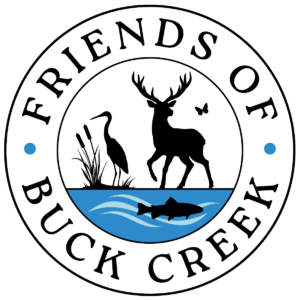Prepared by Schrems West Michigan Trout Unlimited
With support from EGLE (Environment, Great Lakes, and Energy – State of Michigan)
The goal of this Watershed Management Plan (WMP) is to assist the Buck Creek community in ensuring the long-term protection and improvement of the creek and surrounding lands, with focus on the designated uses applicable to the Buck Creek Watershed that are mandated by state and federal water quality programs. This WMP is intended, among other things, to provide a shared strategy for moving community jurisdictions and organizations forward with respect to water quality as affected by nonpoint source pollutants. Nonpoint source pollution can include: Excess fertilizers, herbicides and insecticides from agricultural lands and residential areas. Oil, grease and toxic chemicals from urban runoff and energy production. Sediment from improperly managed construction sites, crop and forest lands, and eroding streambanks.
Watershed management plans are intended to be a guidebook to be used by individuals and organizations interested in protection, improvement and wise use of our lands and waters. This WMP has been organized in a manner intended to promote short and long-term measures that can be easily identified and efficiently implemented. The WMP has been divided into the following chapters, which, to a degree, can be read and used collectively, or independently. Chapter 2 has been crafted to stand alone as the primary driver for watershed protection and restoration. The latter seven chapters provide the information used to write Chapter 2 and all of the information necessary to meet the required nine elements. In other words, Chapters 3-9 contain supporting information, data and analyses that may or may not be of interest to readers.
Download the Buck Creek Watershed Management Plan (PDF)
The following chapters provide all of the pertinent background information, data, state and federal requirements, etc. that were used to create the Action Plan:
Chapter 2. Action Plan provides a list of activities that are recommended to protect and/or restore Buck Creek and its watershed. While this chapter is not meant to be all inclusive, it is a synopsis all of the information collected and analyzed for this plan and was written to stand alone as a “Quick Start” guidebook to be used by stakeholders of the resource.
Chapter 3. Description of the Buck Creek Watershed. This chapter provides a general overview of the BCW. This is background information that does not include specific recommendations for project
implementation.
Chapter 4. Water Quality in the Buck Creek Watershed – An Overview explains Water Quality Standards (WQS) in the State of Michigan, the protected designated uses that surface water bodies must attain and the pollutants that impair or threaten the designated and desired uses of the BCW. As well, the chapter includes detailed summaries of all data reviewed, collected and analyzed during this planning
process.
Chapter 5. Pollutants, Sources and Causes lists all of the NPS pollutants that have been identified within the BCW. Where required, a loading estimate was calculated to determine overall contribution, and the source and cause of each pollutant was identified or speculated.
Chapter 6. Critical Sites/Areas and Pollutant Loading are those areas that are in dire need of attention to improve overall water quality. Each critical site/area identified is mapped and included in a table, with the
estimated volume of pollution from that site.
Chapter 7. Addressing NPS Pollution to Protect/Restore Designated Uses makes recommendations for what needs to occur in the BCW, in terms of addressing critical sites and areas, information and education outreach and changes in local policies. Estimated costs for all improvements are included.
Chapter 8. Evaluation and Monitoring Plan provides the information necessary for measuring the successfulness of implementing this WMP.
Chapter 9. Literature Cited includes all of the studies and documents referenced in this WMP.

